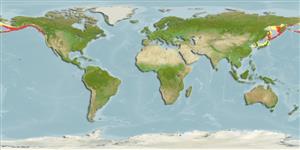Teleostei (teleosts) >
Perciformes/Zoarcoidei (Eelpouts and pricklebacks) >
Zaproridae (Prowfish)
Etymology: silenus: Named after Silenus, a drunkard demigod who fell in a marsh on a revel and became covered with slime (Ref. 6885).
More on author: Jordan.
Environment: milieu / climate zone / depth range / distribution range
Ecology
Marine; demersal; depth range 0 - 675 m (Ref. 50550), usually 0 - 500 m (Ref. 28981). Boreal; 0°C - 4°C (Ref. 56462); 66°N - 34°N
North Pacific: Hokkaido, Japan and western Kamchatka, Russia to Navarin Canyon in the Bering Sea, Attu Island in the Aleutian chain and San Miguel Island, California, USA.
Length at first maturity / Size / Weight / Age
Maturity: Lm 57.0 range ? - ? cm
Max length : 88.0 cm TL male/unsexed; (Ref. 2850); common length : 42.9 cm TL male/unsexed; (Ref. 56462); max. published weight: 7.0 kg (Ref. 56462); max. reported age: 9 years (Ref. 56462)
Adults occur near bottom (Ref. 2850). Young to 7.2 cm are pelagic or bathypelagic, usually associated with jellyfish (Ref. 6885). Juveniles take shelter under the medusae and are often mistaken for medusafish Icichthys lockingtoni (Ref. 50276).
Life cycle and mating behavior
Maturities | Reproduction | Spawnings | Egg(s) | Fecundities | Larvae
Eschmeyer, W.N., E.S. Herald and H. Hammann, 1983. A field guide to Pacific coast fishes of North America. Boston (MA, USA): Houghton Mifflin Company. xii+336 p. (Ref. 2850)
IUCN Red List Status (Ref. 130435)
Threat to humans
Harmless
Human uses
Fisheries: subsistence fisheries
Tools
Special reports
Download XML
Internet sources
Estimates based on models
Preferred temperature (Ref.
123201): 1.4 - 8.9, mean 4.7 °C (based on 1470 cells).
Phylogenetic diversity index (Ref.
82804): PD
50 = 1.5000 [Uniqueness, from 0.5 = low to 2.0 = high].
Bayesian length-weight: a=0.01738 (0.00680 - 0.04443), b=2.97 (2.75 - 3.19), in cm total length, based on LWR estimates for this (Sub)family-body shape (Ref.
93245).
Trophic level (Ref.
69278): 3.7 ±0.1 se; based on diet studies.
Generation time: 6.1 ( na - na) years. Estimated as median ln(3)/K based on 1
growth studies.
Resilience (Ref.
120179): Low, minimum population doubling time 4.5 - 14 years (tm= 5.1; K= 0.18).
Fishing Vulnerability (Ref.
59153): Moderate to high vulnerability (54 of 100).
Nutrients (Ref.
124155): Calcium = 17.6 [9.1, 33.0] mg/100g; Iron = 0.374 [0.139, 0.762] mg/100g; Protein = 15.8 [12.9, 19.4] %; Omega3 = 0.282 [0.150, 0.532] g/100g; Selenium = 22 [9, 54] μg/100g; VitaminA = 4.75 [0.88, 24.05] μg/100g; Zinc = 0.289 [0.193, 0.435] mg/100g (wet weight); based on
nutrient studies.
